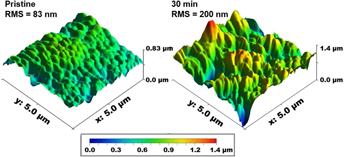Crossref Citations
This article has been cited by the following publications. This list is generated based on data provided by
Crossref.
Sun, Hao
Li, Dan
Liu, Bing
and
Yao, Jie
2019.
Enhancing the permeability of TFC membranes based on incorporating polyamide matrix into MWCNTs framework.
Applied Surface Science,
Vol. 496,
Issue. ,
p.
143680.
Sun, Hao
Liu, Yijun
Li, Dan
Liu, Bing
and
Yao, Jie
2019.
Hydrophobic SiO2 nanoparticle‐induced polyvinylidene fluoride crystal phase inversion to enhance permeability of thin film composite membrane.
Journal of Applied Polymer Science,
Vol. 136,
Issue. 45,
Suriani, A. B.
Muqoyyanah
Mohamed, A.
Othman, M. H. D.
Rohani, R.
Yusoff, I. I.
Mamat, M. H.
Hashim, N.
Azlan, M. N.
Ahmad, M. K.
Marwoto, P.
Sulhadi
Kusuma, H. H.
Birowosuto, M. D.
and
Khalil, H. P. S. Abdul
2019.
Incorporation of Electrochemically Exfoliated Graphene Oxide and TiO2 into Polyvinylidene Fluoride-Based Nanofiltration Membrane for Dye Rejection.
Water, Air, & Soil Pollution,
Vol. 230,
Issue. 8,
Lasisi, Kayode
Yao, Weihao
Ajibade, Temitope
Tian, Huali
Fang, Fang
and
Zhang, Kaisong
2020.
Impacts of Sulfuric Acid on the Stability and Separation Performance of Polymeric PVDF-Based Membranes at Mild and High Concentrations: An Experimental Study.
Membranes,
Vol. 10,
Issue. 12,
p.
375.
Sakarkar, Shruti
Muthukumaran, Shobha
and
Jegatheesan, Veeriah
2020.
Polyvinylidene Fluoride and Titanium Dioxide Ultrafiltration Photocatalytic Membrane: Fabrication, Morphology, and Its Application in Textile Wastewater Treatment.
Journal of Environmental Engineering,
Vol. 146,
Issue. 7,
Al-Gharabli, Samer
and
Kujawa, Joanna
2021.
Molecular activation of fluoropolymer membranes via base piranha treatment to enhance transport and mitigate fouling – new materials for water purification.
Journal of Membrane Science,
Vol. 624,
Issue. ,
p.
119105.
Jiménez-Robles, Ramón
Moreno-Torralbo, Beatriz María
Badia, Jose David
Martínez-Soria, Vicente
and
Izquierdo, Marta
2022.
Flat PVDF Membrane with Enhanced Hydrophobicity through Alkali Activation and Organofluorosilanisation for Dissolved Methane Recovery.
Membranes,
Vol. 12,
Issue. 4,
p.
426.
Chou, Fang-Yu
Hara, Shintaro
Uchida, Kazuto
Matsuo, Youichi
Masuda, Tsukuru
Yokoi, Ryo
Ono, Toshiya
Anraku, Masaki
Isoyama, Takashi
and
Takai, Madoka
2022.
Functionalized Silicone Elastomer via Alkaline Solution to Coat Phosphorylcholine-Based Copolymer Containing Organosilane to Improve Hemocompatibility for Medical Devices.
Frontiers in Materials,
Vol. 9,
Issue. ,
Zięba, Monika
Rusak, Tomasz
Misztal, Tomasz
Zięba, Wojciech
Marcińczyk, Natalia
Czarnecka, Joanna
Al-Gharabli, Samer
Kujawa, Joanna
and
Terzyk, Artur P.
2022.
Nitrogen plasma modification boosts up the hemocompatibility of new PVDF-carbon nanohorns composite materials with potential cardiological and circulatory system implants application.
Biomaterials Advances,
Vol. 138,
Issue. ,
p.
212941.
Thamizhlarasan, Anbarasan
Vignesh, Ramamoorthi
Anbarasan, Ramasamy
and
Tung, Kuo‐Lun
2022.
Synthesis and characterization of functionalized polyvinylidene fluoride (PVDF) and the high temperature catalytic activity of PVDF‐g‐MAH/V2O5 nanocomposite toward transesterification reaction.
Polymer Engineering & Science,
Vol. 62,
Issue. 9,
p.
3010.
Wang, Yuchi
Zhang, Jingji
Gao, Huifang
Yao, Yaxuan
Pu, Cheng
Wang, Jiangying
Ren, Lingling
and
Zong, Quan
2023.
The interface effects on the breakdown strength of multilayer PVDF-based capacitors.
Polymer,
Vol. 270,
Issue. ,
p.
125803.
Yeow, Andrew T.H.
Chan, Mieow Kee
Ong, Chi Siang
and
Ho, Kah Chun
2024.
Effects of hydrogen bond donors on PVDF membrane modification using choline chloride-based deep eutectic solvents.
Journal of Industrial and Engineering Chemistry,
Vol. 139,
Issue. ,
p.
514.
Kujawa, Joanna
Pianka, Katarzyna
Al-Gharabli, Samer
Jankowski, Waldemar
Flanc, Zuzanna
and
Kujawski, Wojciech
2024.
Rare earth metal oxides smart modifiers in 3D re-entrant surface architecture for efficient membrane separation.
Desalination,
Vol. 586,
Issue. ,
p.
117788.




